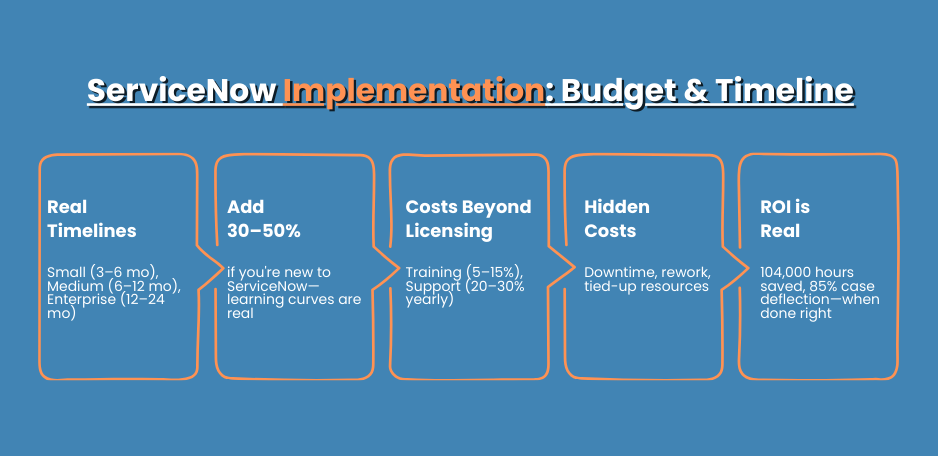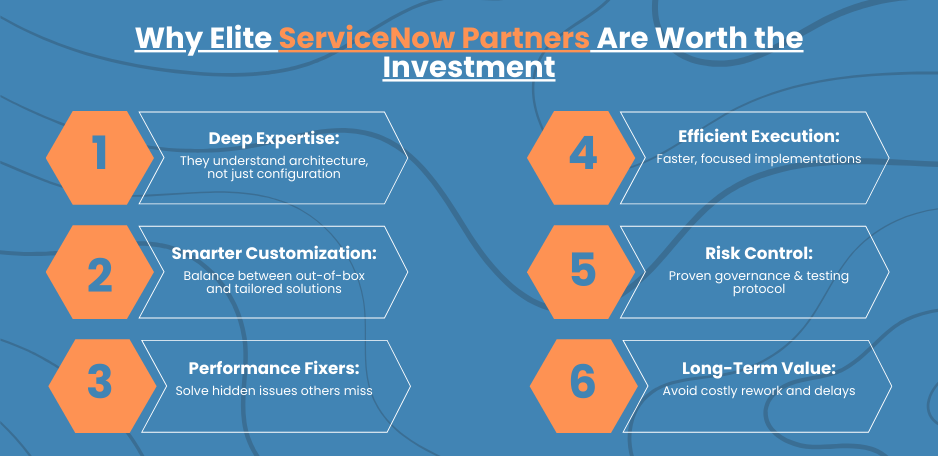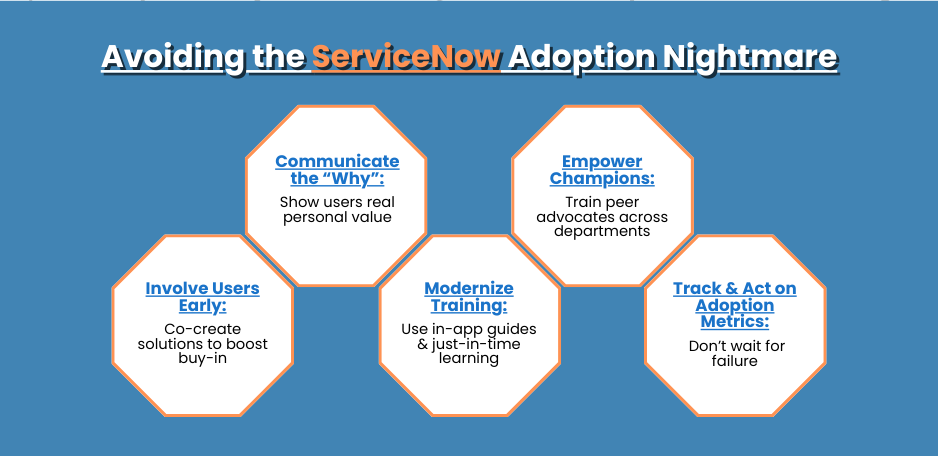
Ever watched a toddler tackle a 1,000-piece puzzle? That’s how many IT leaders feel staring down a ServiceNow implementation. The box looks promising—streamlined workflows, automated processes, unified data. Yet the scattered pieces tell a different story.
Legacy systems aren’t just outdated—they’re actively sabotaging productivity. A ServiceNow survey found 68% of users describe their current ITSM systems as “clunky” and “difficult to use.” No wonder the ServiceNow market projects 17.6% annual growth through 2034. Organizations are desperate for something better.
But here’s the uncomfortable truth: about 70% of digital implementations crash and burn. Not because the technology fails, but because the implementation goes sideways. Poor planning, budget miscalculations, inadequate resources—the implementation graveyard is filled with well-intentioned projects that never delivered their promised ROI.
We’ve watched brilliant technical teams get completely derailed by the deceptive simplicity of ServiceNow. “It’s just configuration,” they insist, right before disappearing into a six-month quagmire of custom scripts and integration headaches. The platform’s versatility becomes both a blessing and curse—you can do almost anything, which means you might try to do everything.
The stakes couldn’t be higher. Your team is drowning in tickets. SLAs are consistently missed. The business views IT as a bottleneck rather than an enabler. Something has to change, but the implementation path feels treacherous.
Let’s cut through the uncertainty and map a clear path from your current chaos to ServiceNow clarity.
Counting the Cost: Time and Budget Realities
ServiceNow implementations aren’t cheap, and they’re rarely quick. Anyone telling you otherwise is setting you up for disappointment. The real question isn’t whether you’ll invest—it’s whether that investment will pay off.

Time estimates vary dramatically based on scope and complexity:
- Small implementations (single module, limited customization): 3-6 months
- Medium implementations (multiple modules, moderate customization): 6-12 months
- Enterprise implementations (organization-wide, high customization): 12-24 months
These timeframes assume you’ve got experienced resources dedicated to the effort. First-time implementers typically add 30-50% to these estimates—learning curves are steep, and mistakes inevitable.
As for costs, they break down across several categories:
Licensing costs vary wildly based on modules and user counts. But implementation services often match or exceed first-year licensing—a reality many organizations fail to budget for. Training costs depend on team size and depth, but typically run 5-15% of implementation costs. And don’t forget ongoing maintenance and support, which typically run 20-30% of initial implementation costs annually.
The hidden costs? Lost productivity during transition, opportunity costs of tying up internal resources, and the inevitable rework when initial configurations miss the mark.
Once watched a mid-sized financial services firm budget $250,000 for their ServiceNow implementation. Eighteen months and $1.2 million later, they finally went live. The platform worked beautifully—but the CFO nearly had a coronary.
The ROI calculation looks daunting on paper. But organizations that implement effectively see dramatic returns. Standard Chartered Bank saved 104,000 annual productive hours. Another organization achieved 85% case deflection through self-service. These aren’t marketing claims—they’re documented outcomes from organizations that approached implementation strategically.
The key isn’t minimizing investment but maximizing return. That starts with making the right implementation choices from day one.
DIY or Partner Up? The Critical Decision
Let’s have an uncomfortable conversation about your team. They’re talented. Dedicated. Possibly overworked. But are they the right resources for this implementation?
The DIY approach tempts many organizations. After all, your team knows your business best. You’ve hired smart people. Surely they can figure out ServiceNow configuration?
Before jumping in, ask yourself these questions:
- Does your team have bandwidth to invest hundreds of hours while maintaining existing services?
- Do they have ServiceNow-specific expertise beyond basic administration?
- Can they objectively evaluate current processes rather than simply automating inefficiency?
- Will customers accept slower delivery of other priorities during implementation?
The brutal truth? Most internal teams lack both the bandwidth and specialized expertise for effective implementation. They’re already maxed out keeping existing systems running. Adding a major implementation creates impossible choices—neglect current responsibilities or shortchange the implementation.
We’ve seen this movie too many times. The implementation starts strong but gradually stalls as daily emergencies pull resources away. Six months in, you’ve got a half-configured platform, frustrated users, and mounting pressure to show results. Not exactly the transformation you envisioned.
This doesn’t mean your team has no role. They bring invaluable process knowledge and will ultimately own the platform. But partnering with ServiceNow experts—whether through ServiceNow Professional Services or an Elite Partner—provides critical advantages:
Specialized expertise makes all the difference. Partners bring pattern recognition from dozens or hundreds of implementations. They’ve seen your challenges before and know which approaches work. They stay current with platform capabilities and best practices, ensuring your implementation leverages ServiceNow’s full potential.
Implementation accelerators compress timelines dramatically. Partners maintain libraries of pre-built components, testing frameworks, and implementation tools refined across multiple projects. These accelerators represent thousands of development hours you benefit from immediately.
Risk mitigation may be the most compelling advantage. Partners assume accountability for implementation success, with contractual commitments to timelines and outcomes. Their implementation methodologies incorporate risk management practices refined through previous engagements.
The most effective approach? A hybrid model that combines partner expertise with internal knowledge. The partner leads architecture and complex configurations while involving your team for process expertise and knowledge transfer. This approach accelerates implementation while building sustainable internal capabilities.
The partner decision significantly impacts both immediate success and long-term value. Choose wisely.
Elite Partners: What Makes Them Worth It
Not all implementation partners deliver equal value. The market’s flooded with firms claiming ServiceNow expertise, but their capabilities vary dramatically. Elite Partners—those with proven implementation track records and specialized expertise—bring distinct advantages worth the premium.

In-depth knowledge separates true experts from casual practitioners. Elite Partners maintain teams immersed in ServiceNow’s evolving capabilities. They don’t just know what buttons to click—they understand architectural implications, performance considerations, and upgrade impacts of implementation decisions. Their consultants have seen how seemingly minor configuration choices can create major headaches down the road.
A client struggled with a ServiceNow implementation that technically “worked” but performed terribly under load. Their original implementer had configured workflows that triggered excessive database queries, creating cascading performance issues. An Elite Partner diagnosed and resolved the issue in days—something the client’s team might never have identified.
Customization balance is another elite differentiator. Average partners either over-customize (creating maintenance nightmares) or rigidly adhere to out-of-box functionality (ignoring legitimate business needs). Elite Partners find the sweet spot—leveraging standard capabilities where possible while applying surgical customization where necessary. They build solutions that meet your unique requirements without creating technical debt.
The efficiency advantage compounds over time. Elite Partners maintain refined implementation methodologies that eliminate waste and focus effort on value-creating activities. Their consultants don’t waste time researching basic platform capabilities or troubleshooting common issues. This expertise translates to faster implementations without sacrificing quality.
Perhaps most valuable is their risk mitigation expertise. They’ve seen implementations go sideways and know the warning signs. Their governance frameworks, testing protocols, and change management approaches prevent the common pitfalls that derail internal implementations.
The cost differential between basic and elite partners often pays for itself in avoided rework and accelerated time-to-value. When evaluating partners, look beyond hourly rates to total cost of ownership and expected outcomes. The cheapest implementation is rarely the most economical in the long run.
Implementation Roadmap That Actually Works
Successful implementations follow a proven roadmap—not a rigid waterfall, but a structured approach that balances planning with flexibility. This roadmap creates clarity without sacrificing adaptability.
Define clear objectives that connect to business outcomes. Vague aspirations like “improve service management” provide insufficient guidance. Instead, target specific metrics: “Reduce incident resolution time by 30% within six months” or “Increase self-service adoption by 50% in the first year.” These precise targets create accountability and focus implementation decisions.
The discovery phase reveals more than just technical requirements. It exposes process inefficiencies, workarounds, and improvement opportunities that configuration alone won’t fix. We’ve seen organizations discover through this process that 40% of their tickets stemmed from a single broken process—a realization that completely shifted implementation priorities.
Prioritization separates successful implementations from endless projects. Not all capabilities deliver equal value. Apply the 80/20 principle—identify the 20% of features that will drive 80% of benefits. This focus prevents scope creep and ensures resources concentrate on high-impact areas first.
The customization trap ensnares countless implementations. ServiceNow’s flexibility tempts organizations to recreate existing processes exactly, customizations and all. Resist this urge. Challenge whether business processes could adapt to standard functionality. When customization is necessary, document the business justification and design with upgrade compatibility in mind.
Phased implementation reduces risk while accelerating time-to-value. Rather than attempting a “big bang” deployment, break implementation into manageable chunks:
- Core incident and request management
- Knowledge and self-service capabilities
- Change and release management
- Asset and configuration management
- Expansion to additional departments
This approach delivers value incrementally while allowing users to adapt gradually to new ways of working.
Testing separates professionals from amateurs. Develop comprehensive test plans covering various scenarios and edge cases. Include both technical testing and user acceptance testing under realistic conditions. Document and address identified issues before go-live. These quality assurance investments pay dividends in reduced support costs and higher user satisfaction.
Governance ensures long-term platform integrity. Define clear decision-making processes for platform changes, establish development and testing standards, implement appropriate access controls, and schedule regular platform health assessments. Without governance, even well-implemented platforms gradually degrade through inconsistent changes and undocumented modifications.
The most successful organizations view implementation as the beginning, not the end. They schedule regular reviews of platform performance, maintain enhancement backlogs, stay current with ServiceNow releases, and continuously refine based on evolving business needs.
This structured yet flexible approach delivers both immediate wins and sustainable long-term value.
Avoiding the Adoption Nightmare
The most technically perfect implementation fails without user adoption. We’ve seen flawlessly configured ServiceNow instances sitting nearly empty while users continue with spreadsheets, emails, and hallway conversations. Technical success means nothing without organizational adoption.

Low adoption stems from several common issues:
- Insufficient stakeholder engagement throughout design and implementation
- Inadequate training on new processes and tools
- Poor change management that fails to address resistance
- Implementations that ignore user experience and workflow realities
The forgetting curve compounds these challenges. Research shows humans forget 50% of new information within a day and 90% within a week. Traditional training approaches—one-time sessions weeks before go-live—virtually guarantee failure.
Effective adoption strategies start early and continue long after implementation:
Involve users from day one. Not just in requirements gathering, but throughout design and testing. Users who help shape the solution become its strongest advocates. Create user experience committees with representatives from different departments and roles. Their insights identify usability issues before they become adoption barriers.
Communicate relentlessly about the “why.” Users adopt changes when they understand the benefits—not just for the organization but for their daily work. Create messaging that emphasizes “what’s in it for me” for each user group. Share success stories and metrics that demonstrate improvements.
Training must evolve beyond classrooms. Combine formal sessions with just-in-time resources available at the moment of need. Consider digital adoption platforms that provide in-app guidance, context-sensitive help, and interactive walkthroughs. These tools dramatically improve knowledge retention and application.
Identify and empower champions within each department. These power users receive advanced training and serve as local experts and advocates. Their peer influence often proves more effective than top-down mandates or formal training.
Measure adoption continuously using metrics like active users, self-service utilization, and feature adoption rates. Address declining trends immediately rather than waiting for complete adoption failure.
The most successful implementations treat adoption as a primary workstream—not an afterthought. They allocate resources specifically to change management and user enablement, recognizing that technical excellence means nothing without user engagement.
Measuring Success Beyond Go-Live
The go-live date marks the beginning, not the end, of your ServiceNow journey. True success requires ongoing measurement across multiple dimensions.
User adoption metrics provide the foundation. Track active users as a percentage of your target population, self-service utilization rates, knowledge base usage, and feature adoption across different capabilities. Low adoption indicates implementation issues regardless of technical quality.
Process performance improvements demonstrate operational impact. Measures mean time to resolution for incidents, first-contact resolution rates, SLA compliance percentages, change success rates, and cost per ticket. Compare against pre-implementation baselines to quantify benefits.
Business impact measures connect implementation outcomes to strategic objectives. Quantify productivity gains through automation, cost avoidance through self-service, revenue impacts from improved service availability, and effects on customer and employee satisfaction. These higher-level measures justify continued investment and expansion.
Platform health indicators ensure sustainability. Monitor system performance metrics, assess technical debt, evaluate upgrade readiness, verify security compliance, and check integration stability. These technical measures ensure your implementation remains adaptable to changing business needs.
The measurement cadence matters as much as the metrics themselves. Establish regular reviews—weekly immediately after go-live, transitioning to monthly as the platform stabilizes. Use these reviews to identify improvement opportunities and prioritize enhancements.
The most sophisticated organizations create balanced scorecards that integrate these different measurement dimensions. This comprehensive view prevents overemphasizing any single aspect of implementation success.
Remember that metrics drive behavior. If you measure only technical aspects like ticket volume, you’ll get a technically focused implementation. If you measure business outcomes like productivity improvements or customer satisfaction, you’ll get an implementation that delivers real business value.
Next Steps: Making ServiceNow Work For You
ServiceNow implementations represent significant investments with transformative potential. The path from chaos to clarity requires more than technical expertise—it demands strategic vision, organizational alignment, and disciplined execution.
As you consider your implementation approach, focus on these critical success factors:
- Establish clear business objectives aligned with organizational strategy
- Make realistic assessments of internal capabilities and capacity
- Choose implementation partners based on demonstrated expertise and cultural fit
- Follow a structured implementation methodology while maintaining flexibility
- Invest equally in technical configuration and organizational adoption
- Measure outcomes across multiple dimensions, not just technical metrics
The most successful implementations start with clear business objectives, assemble the right combination of internal and partner resources, and maintain relentless focus on user adoption. They balance standardization with necessary customization, implement in manageable phases, and establish governance structures that ensure long-term platform integrity.
The results can be transformative—as demonstrated by organizations achieving dramatic improvements in operational efficiency, service quality, and strategic alignment. These benefits don’t materialize automatically from software deployment. They emerge from thoughtful implementation approaches that address both technical and organizational dimensions of change.
Whether you’re considering your first ServiceNow implementation or looking to optimize an existing deployment, the principles outlined in this guide provide a framework for success. The path from chaos to clarity isn’t always straightforward, but with proper planning, expert guidance, and disciplined execution, your ServiceNow implementation can deliver the transformative results your organization expects.
Ready to start your journey from ServiceNow chaos to clarity? The first step is an honest assessment of your current state, implementation objectives, and internal capabilities. From there, you can develop an implementation approach that balances ambition with pragmatism, setting your organization up for both immediate wins and long-term transformation.
FAQs About ServiceNow Implementation
How long will our ServiceNow implementation actually take?
Every organization’s timeline looks different. Small implementations with focused scope might wrap up in 3-6 months. More complex rollouts involving multiple departments? You’re looking at 6-12 months minimum. The timeline killer isn’t usually the technology—it’s scope creep and resource constraints. We’ve seen a “quick” 3-month project stretch to 9 months because the client kept adding “just one more thing” to the requirements. Better to start focused, deliver value quickly, and build from there. Remember that your team still has their day jobs—unless you’re staffing dedicated resources, expect timelines to stretch.
Do we really need an implementation partner, or can we do this ourselves?
Could you do it yourself? Maybe. Should you? Probably not. Your team knows your business processes are cold, but they likely lack ServiceNow-specific expertise. The platform looks deceptively simple until you hit complex workflows or integrations. Partners bring pattern recognition from dozens of implementations—they’ve seen your challenges before and know which approaches work. Plus, your team is already maxed out keeping systems running. Adding a major implementation creates impossible choices—neglect current responsibilities or shortchange the implementation. The hybrid approach works best: partner expertise plus your team’s process knowledge.
What’s the biggest implementation mistake you see companies make?
Trying to boil the ocean. Companies get excited about ServiceNow’s capabilities and try implementing everything at once. Recipe for disaster! One company attempted to roll out incident, problem, change, asset, and service catalog simultaneously across four departments. Eighteen months later, they had a half-configured mess that nobody used. Start small, nail the basics, build momentum with quick wins, then expand gradually. Your first phase should deliver tangible value within 3-4 months. Get users excited about initial capabilities before adding complexity.
How do we prevent our implementation from becoming shelfware?
Focus obsessively on adoption from day one. The most technically perfect implementation fails if users revert to old habits. Involve key users throughout design—they’ll become your strongest advocates. Create role-specific training that shows exactly how ServiceNow makes their jobs easier. Deploy champions in each department who provide peer support. And ditch the traditional training approach—users forget 90% within a week. Instead, provide guidance within the workflow exactly when they need it. I’ve seen digital adoption platforms boost implementation success rates dramatically by supporting users at their moment of need.
What’s the real cost beyond ServiceNow licensing?
The licensing is just the beginning. Implementation services typically match or exceed first-year licensing costs. Training runs another 5-15% depending on team size. Then there’s ongoing maintenance—figure 20-30% of implementation costs annually. Don’t forget the hidden costs: internal resource time, productivity dips during transition, and inevitable rework when initial configurations miss the mark. One client budgeted $300K for implementation but didn’t account for three full-time internal resources needed. Their actual first-year cost? Closer to $750K. Budget realistically to avoid nasty surprises that could derail your project midstream.






